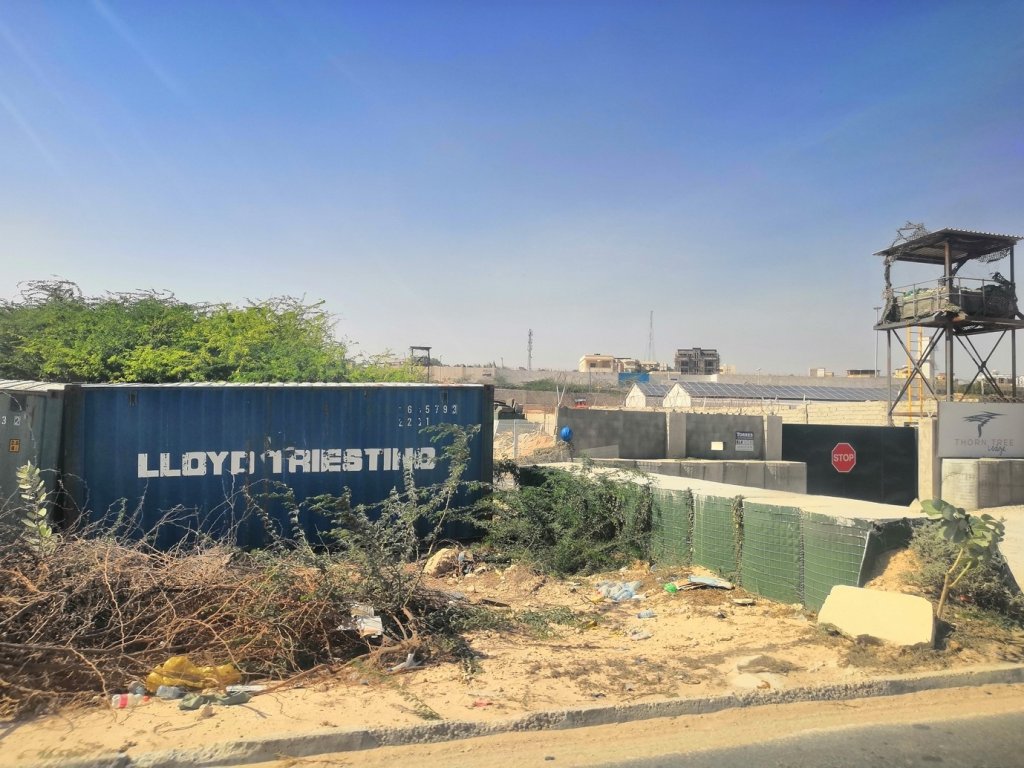Space and materials matter. But how? My article (Open Access) in Security Dialogue explores what spatial and material arrangements reveal about the way international statebuilding exerts (sovereign) power.

Statebuilding interventions support the establishment of sovereign states by taking control of, arranging and ordering spaces. This was immediately apparent when I first entered the Mogadishu International Airport (MIA) zone in 2017, a heavily fortified and militarized enclave in Mogadishu, from where international actors are rolling out programmes to build a state, fight an Islamist insurgency, and alleviate human suffering. Hosting the headquarters of the United Nation’s Somalia programme and the African Union Mission to Somalia (AMISOM); embassies and diplomatic offices; logistic and security companies; warehouses; hotels and restaurants, the MIA zone is separated from the city by walls, fences, barbed wires, and crash barriers.
Movement from Mogadishu into the zone is only possible in daytime, and through one of three heavily guarded gates. Offices, residential compounds, and other installations inside the zone are surrounded by additional walls and entry-barriers. Military and private security are guarding gates, patrolling roads, or gazing down on people from watchtowers. Helicopters cruise above the zone and patrol the shoreline. Tanks, military pick-up trucks and white SUVs move over dusty roads, revealing the militarisation of aid as well as the blurring boundaries of defence, development, and diplomacy characteristic for international statebuilding. The usual archipelago of fortified aid compounds is integrated into one spatial template in the MIA zone.
Zoning, walling, and partitioning are socio-spatial technologies aimed at controlling mobilities while separating good from bad and desired from undesired movements. They also illustrate that people and organisations inside the zone live in constant anticipation of violence and prepare for it. Violence, therefore, remains at the core of statebuilding, internationally supported or not.
The international airport is part of the zone, where containers are found everywhere. They are used to transport goods, assembled to walls, transformed into gyms or warehouses, and refurbished into hotels or restaurants. The airport and containers underscore the centrality of circulation and the importance of infrastructures and logistics. After all, international experts, security personnel and their supplies and technologies need to be deployed quickly as they move across crisis areas, along heavily secured paths within the MIA zone and to similar zones in other Somali cities.
‘The materials and infrastructures used to ensure and control circulation attest to the commercialisation of interventions.’
The materials and infrastructures used to ensure and control circulation attest to the commercialisation of interventions. I show this with the example of a container hotel and Hesco walls. They are provided by private companies that made the delivery of supplies to war and disaster zones their business. Hesco provides blast proof walls and advertise that these walls provide a ‘safe haven’ in remote or hostile environments. The providers of a container village advertise their ability to deliver a combination of security, comfort, care, and wellbeing to staff operating in risky environments. Both companies extend the humanitarian gesture of care to those who made the delivery of aid their profession.
The container village and Hesco wall are also examples for modular designs that dominate the MIA zone. Modularity enables the exchange of compartments from an interconnected system. This helps to contain the impacts of shocks but also makes installations adaptable and moveable. The MIA zone is composed of modular installations that can be speedily assembled, disassembled and, in different combinations, reassembled and used elsewhere. Modular installations are built to disappear as soon as the disaster is managed, the crisis under control or the state enabled to work. They obfuscate the differentiation between what is fixed and what mobile; solid or fluid; lasting or short time; durable or make-shift. Ironically, the mobility and fluidity of these installations makes them durable and allows them to move in different arrangements through crisis and disasters. Modular installations point to a form of sovereign power that is detached from the state while trying to deny its own power. It operates through mobile, modular, and transitory arrangements of an elusive humanitarian-military-diplomatic-aid apparatus.
‘The spaces and materials created by modular forms of sovereign power remain elusive, but nonetheless stratify experiences of power and security.’
Spaces such as the MIA zone constitute shifting, fragmented and elastic frontiers. They point towards a logic of rule that is itself modular and contradict the territorial fixes associated with sovereign statehood. The spaces and materials created by modular forms of sovereign power remain elusive, but nonetheless stratify experiences of power and security.